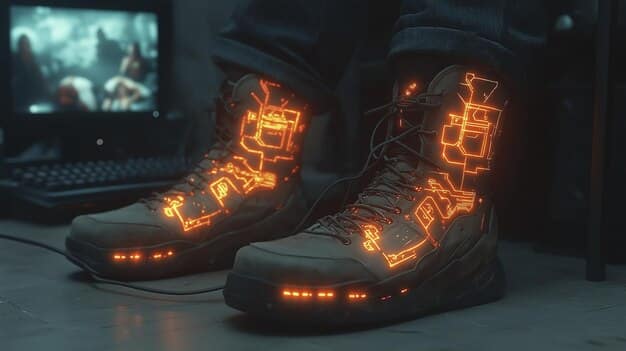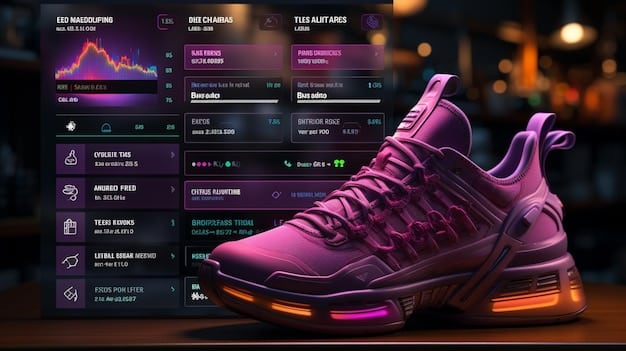Are Sneaker Bots Worth It? Success Rates & Costs Analyzed

Are sneaker bots worth it? This data-driven analysis explores success rates, costs, and ethical considerations to help you decide if using a bot is the right strategy for acquiring limited-edition sneakers.
The world of sneaker collecting has become increasingly competitive, with limited-edition releases selling out in seconds. In this landscape, sneaker bots—software designed to automate the purchasing process—have emerged as a controversial tool. But are sneaker bots worth it? A data-driven analysis of success rates and costs is crucial to understanding their actual value.
Understanding Sneaker Bots: How They Work
Sneaker bots are automated programs designed to purchase sneakers online faster than any human could. They work by automating tasks like adding items to a cart, filling out billing information, and completing the checkout process.
These bots exploit vulnerabilities or leverage speed to bypass security measures meant to ensure fair access to sought-after sneakers. However, their use raises ethical questions within the sneaker community.
The Mechanics of a Sneaker Bot
Sneaker bots operate on various principles, but their core function is speed and automation. They continuously monitor websites for specific sneaker releases and rapidly execute the purchase process when the product becomes available.
Different Types of Bots
There are several types of sneaker bots, ranging from simple browser extensions to sophisticated software applications. Some are designed for specific websites, while others can be used across multiple platforms.
- Dedicated Bots: These bots are tailored to work with one or a few specific sneaker retailers, like Nike SNKRS or Adidas. Since they’re hyper-focused, they often offer higher success rates on those particular sites.
- All-in-One Bots: All-in-one bots attempt to work on multiple sneaker retail sites. They offer flexibility but might not be as effective as dedicated bots on specific platforms.
- Browser Extensions: These are less powerful but more affordable and easier to use. They automate the checkout process on a web browser.
In conclusion, sneaker bots represent a technological arms race within sneaker culture, employing automation and speed to gain an edge but raising concerns about fairness and accessibility.

The Cost of Entry: Bot Prices and Associated Expenses
Acquiring and operating a sneaker bot comes with a range of costs. The initial purchase price of the bot is just the beginning, as additional expenses, such as proxies and server costs, can significantly impact the overall investment.
Before investing in a bot, it’s important to consider not only the upfront price but also the ongoing expenses that are required to maintain its effectiveness.
Sneaker Bot Pricing Ranges
The cost of a sneaker bot varies widely, depending on its capabilities, features, and the demand for its services. Some bots are available for a few hundred dollars, while others can cost thousands.
Additional Expenses: Proxies and Servers
Proxies and servers are essential components of a sneaker bot setup. Proxies mask the user’s IP address, allowing the bot to submit multiple purchase requests without being blocked. Servers provide the computational power needed to run the bot efficiently.
- Proxies: These hide your IP address, allowing you to make multiple requests without being blocked. Good proxies are essential, and they come at a recurring cost.
- Servers: Fast servers reduce latency and increase your bot’s speed, improving your chances of success. Like proxies, servers usually require a monthly subscription.
- Captchas: Some bot services also sell captcha-solving services, which automatically bypass those annoying “I am not a robot” checks.
In conclusion, while a sneaker bot can be a powerful tool, its effectiveness is determined by factoring in the costs of the bot itself, proxies, servers, and other services. Only by looking at the total cost of entry can collectors determine if its value is worth the price.
Deciphering Success Rates: What Data Reveals
Analyzing the success rates of sneaker bots is challenging due to the lack of transparency and the variability of each sneaker release. However, by examining available data and user reports, we can get a sense of their effectiveness.
Understanding these success rates, albeit imperfectly, is crucial for potential buyers to assess whether the investment in a bot is likely to yield the desired results.
Factors Influencing Success Rates
Numerous factors influence the success rates of sneaker bots, including website anti-bot measures, the popularity of the sneaker release, and the quality of the bot and its setup.
User Experiences and Reports
User experiences and reports offer valuable insights into the real-world performance of sneaker bots. These reports can highlight the strengths and weaknesses of different bots and provide guidance on how to optimize their setup.
- Limited Data: Getting concrete success rates is tough. Bot developers often inflate numbers, and individual results vary wildly.
- Release-Specific Success: A bot that works well on one release might fail on another due to changes in website security or simply overwhelming demand.
- User Testimonials: Check forums and online communities for user reviews. Be skeptical, but look for patterns in reported success and failure.
In conclusion, success rates for sneaker bots are difficult to pin down definitively, but analyzing available data and user reports is crucial for those considering using bots to gain an edge in limited-edition sneaker releases.

The Ethical Debate: Fair Access vs. Automation
The use of sneaker bots raises significant ethical questions about fairness and accessibility in the sneaker market. While bot users argue that they are simply leveraging technology to increase their chances of success, critics argue that bots give an unfair advantage to those with the resources to acquire and operate them.
Exploring the ethical dimensions of sneaker bots is essential to understanding their impact on the sneaker community and the values that underpin it.
Arguments for Using Bots
Proponents of sneaker bots argue that they are simply using available tools to compete in a highly competitive market. They contend that bots level the playing field, allowing individuals to compete with resellers and other large-scale buyers.
Arguments Against Using Bots
Critics of sneaker bots argue that they undermine the principles of fair access and inclusivity in the sneaker market. They contend that bots exacerbate existing inequalities by giving an unfair advantage to those with the resources to acquire and operate them.
- Fairness: Bots give an unfair advantage to those who can afford them, pushing out genuine fans who can’t compete with automated systems.
- Accessibility: Bots concentrate limited-edition sneakers in the hands of resellers, making them harder (and more expensive) for regular consumers to obtain.
- Community Impact: Botting erodes the sense of community and passion, turning sneaker collecting into a purely transactional endeavor.
In conclusion, the use of sneaker bots creates ethical dilemmas concerning the balance between technological advancements and principles of fair access within the sneaker community.
Alternatives to Bots: Strategies for Manual Copping
For those who oppose using sneaker bots or cannot afford them, several strategies can be employed to improve their chances of securing limited-edition releases manually. These strategies include optimizing internet speed, using multiple devices, and staying informed about release information.
Exploring these alternatives empowers collectors to pursue their passion for sneakers without compromising their ethical values or incurring the high costs associated with bots.
Optimizing Internet Speed and Devices
Having a fast and reliable internet connection is crucial for manual copping. Additionally, using multiple devices, each with a different IP address, can increase the chances of success.
Staying Informed and Prepared
Staying informed about release information, including drop times, product details, and website layouts, is essential for manual copping. Being prepared with accurate payment information and shipping addresses can also save valuable time during the checkout process.
- Fast Internet: A stable, high-speed connection is essential. Consider upgrading your internet plan if possible.
- Multiple Devices: Use multiple computers, tablets, and phones, each with a different IP address, to increase your chances.
- Manual Input: Practice entering your payment and shipping information quickly and accurately.
In conclusion, while manual copping may not guarantee success, its methods can improve collectors’ odds and offer an experience more harmonious with the values promoted within the Sneaker Culture category.
Future Trends: The Evolving Bot Landscape
The landscape of sneaker bots is constantly evolving, with developers continuously innovating to stay ahead of website security measures. As anti-bot technologies become more sophisticated, bots will likely become more complex and expensive.
Understanding these trends is crucial for anyone considering investing in or using sneaker bots, as it can help them anticipate future challenges and opportunities.
Advancements in Anti-Bot Technology
Website security measures are becoming increasingly sophisticated, making it more difficult for bots to bypass them. These measures include advanced captcha systems, IP address tracking, and behavioral analysis.
The Rise of AI-Powered Bots
Some developers are exploring the use of artificial intelligence (AI) to create bots that can adapt to changing website security measures and mimic human behavior more effectively. These AI-powered bots could potentially offer higher success rates, but they would also likely come at a higher cost.
- Increased Sophistication: Bot developers will continue to find ways to bypass security measures, leading to a constant arms race.
- AI Integration: Expect to see more bots using AI to mimic human behavior and adapt to changing website layouts.
- Tighter Restrictions: Retailers will likely implement stricter anti-bot measures, making it even harder for bots to succeed.
In conclusion, the future of sneaker bots will likely be marked by increasing sophistication and complexity, driven by advancements in both bot technology and anti-bot measures. Only bots with sophisticated components, such as those with AI integration, may succeed in the future.
| Key Aspect | Brief Description |
|---|---|
| 🤖 Bot Cost | Ranges from hundreds to thousands of dollars. |
| ⚡ Success Rates | Influenced by bot quality, website security, and release popularity. |
| ⚖️ Ethical Concerns | Bots raise questions about fairness and accessibility. |
| 🌐 Alternatives | Manual copping strategies include optimizing internet and staying informed. |
Frequently Asked Questions
▼
Sneaker bots are automated programs engineered to rapidly purchase sneakers online, exploiting technical infrastructure to increase chances of acquiring limited edition releases, outperforming manual buyers.
▼
Prices vary widely, from a few hundred dollars for basic versions to several thousand for advanced, high-performance bots. Consider ongoing expenses like proxies, servers and maintenance.
▼
While not explicitly illegal, their use often violates a retailer’s terms of service. Each retailer has its own set of rules and restrictions and can ban users accordingly.
▼
Alternatives include optimizing internet speed, using multiple devices, manually entering payment info quickly, following social media closely and understanding release mechanics unique to each platform.
▼
No, sneaker bots do not guarantee success. Website security measures, limited stock, bot sophistication, and even a simple human mistake can lead to a bot run’s failure.
Conclusion
In conclusion, determining whether sneaker bots are worth it depends heavily on individual circumstances and priorities. While bots can increase the chances of securing limited-edition sneakers, they come with significant costs, ethical considerations, and no guarantee of success. Collectors must weigh these factors carefully before deciding whether to invest in this technology.





